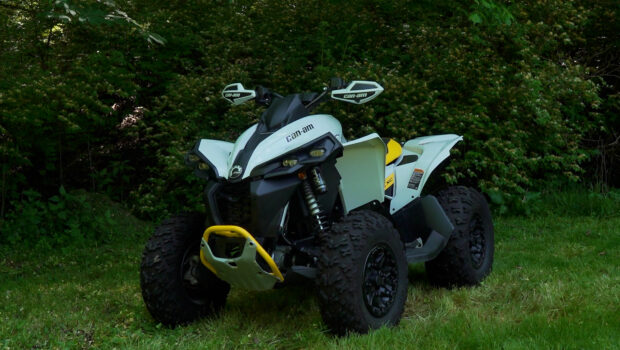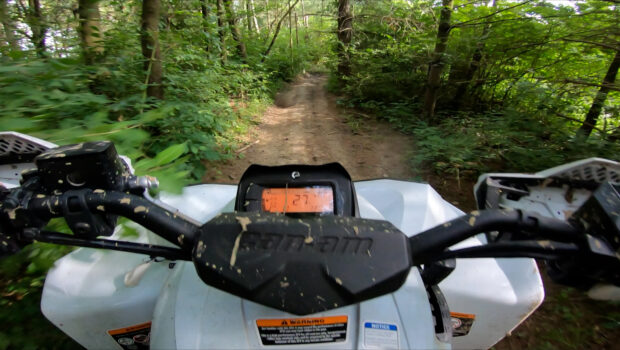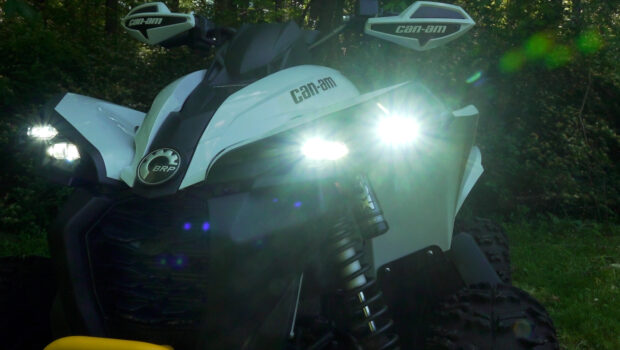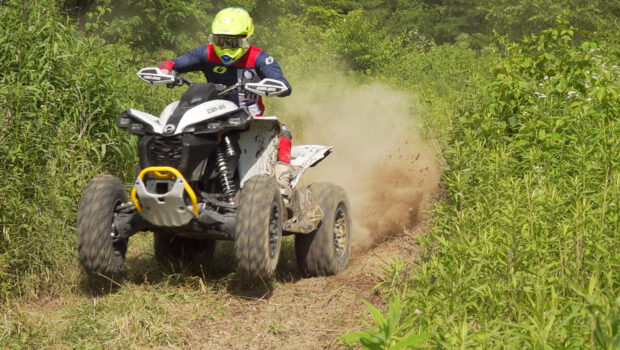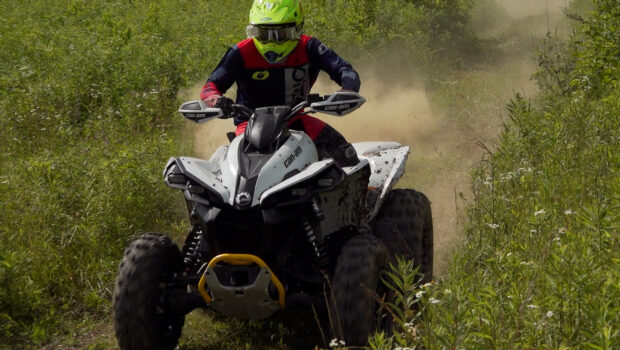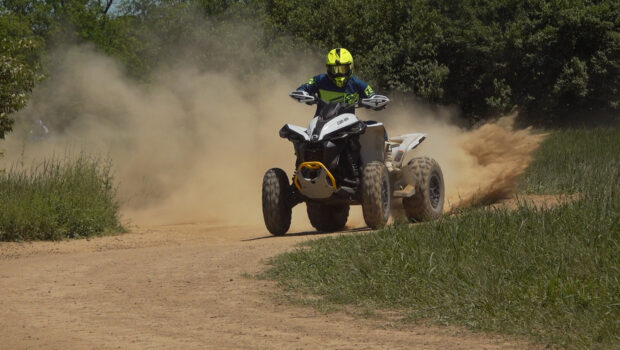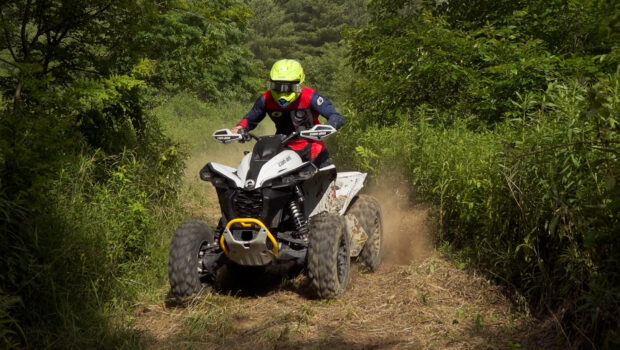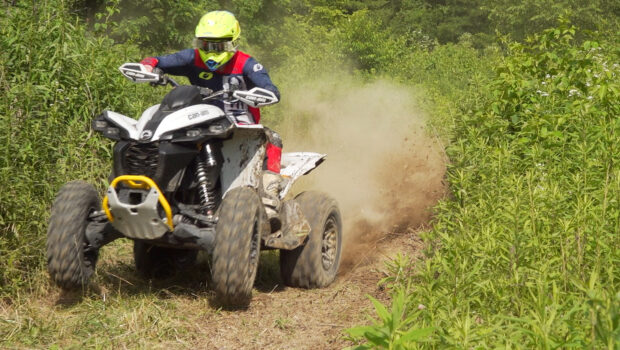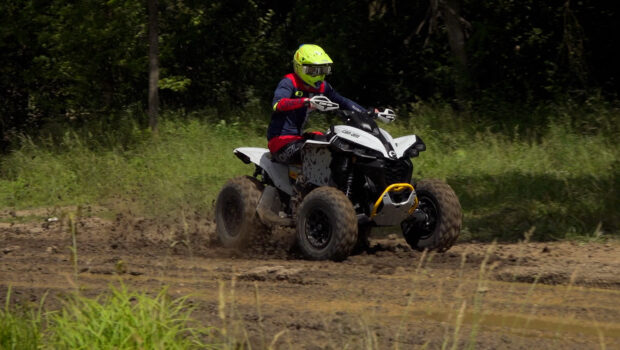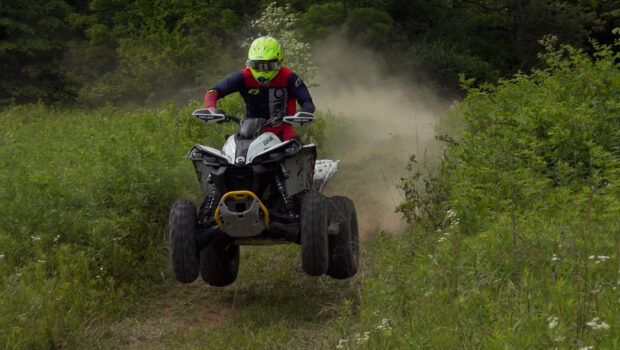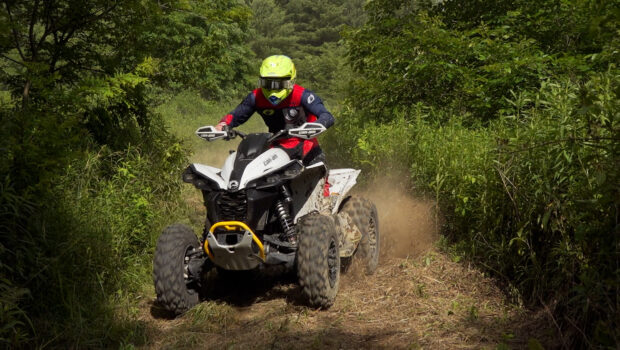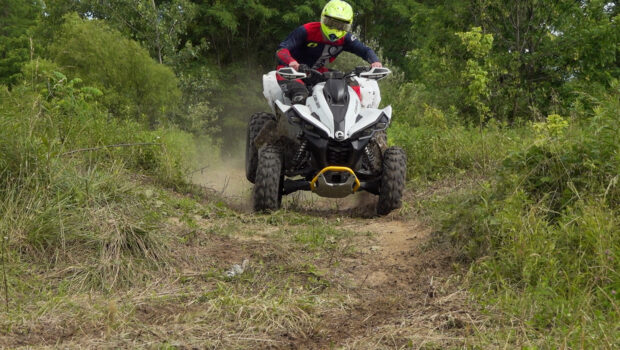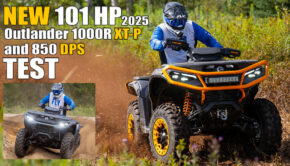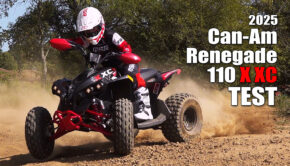2024 Can-Am Renegade 1000R X XC Test Review
2024 Can-Am Renegade 1000R X XC Test Score
Summary: The Renegade 1000R X XC is still the top sport 4x4 for GNCC racing or aggressive riding in tighter terrain, and it just seems to keep getting better.
4.2
3 Month Test
Based on its incredibly disproportionate number of GNCC racing championships, the Can-Am Renegade 1000R X XC is unrivaled in the sport 4×4 segment on intermediate to tight trails. With our most recent test in 2021, and its most recent round of updates in 2023, we felt it was time for a fresh test of one of ATVing’s most thrilling machines.
Updates
Released in 2007 as the Renegade 800, with the addition of the 1000 in 2012, the Can-Am Renegade is a model that has been regularly and significantly updated throughout its life. Its most significant recent update was in 2019 when the track width was widened two-inches with completely redesigned high-clearance A-Arms up front and longer, wider Torsional Trailing Arms out back along with a slightly updated frame to match. The added width was accompanied by recalibrated shocks and sway bars. Wheel travel was increased 2/10” up front and 6/10” out back. Horsepower increased from 89 to 91 HP and Intelligent Throttle Control with selectable throttle modes was added. The rear differential was made a claimed 50% stronger.
2021 brought with it a new gauge. For 2023, the Renegade’s round halogen headlights were replaced with four rectangular LEDs. The front fascia was redesigned with a new look and easily removable front grill allowing easier radiator cleaning. Perhaps most significant was the addition of Intelligent engine braking, allowing the rider to select between three different levels of engine braking.
Trim Packages
As a premium performance machine, Can-Am is currently only offering the Renegade 1000R in two trim packages in 2024. They include the XC racing focused X XC package featuring 25” tires mounted on 12” aluminum beadlock wheels, fully-adjustable Fox Podium shocks, Aluminum tapered handlebars with full wrap handguards plus X-package coloration and seat cover. Top shelf performance comes with a top-shelf price of $15,949
For hard-core mud riding, Can-Am also offers the Renegade X MR 1000R, which comes fully appointed for Mud racing or dedicated mud riding, retailing for $17,249.
Engine Performance
Said to produce 94HP with the use of premium pump gas, the Renegade is powered by a 976cc, V-twin, liquid cooled Rotax engine, fueled via electronic fuel injection from its 5.4 gal tank. The top-end is mated to a fully automatic, continuously variable transmission (CVT) featuring low and high forward ranges plus neutral reverse and park.
With the use of Can-Am’s digitally encoded security system key, the Renegade fires up and warms up quickly. The one-liter, Rotax, V-twin produces immediate, in your face power right off idle. It’s magnified by snappy, responsive clutch tuning off idle, and seemingly at all points in the RPM range. Power builds at a blistering pace throughout the midrange with mind blowing top-end power. Not for the inexperienced or faint of heart, it’s scary fast at all points in the RPM range.
If 91HP isn’t enough, there’s an additional 10-15% available with the installation of a good aftermarket exhaust like HMF’s Titan or Performance Series, when paired with their pre-programmed Fuel Optimizer, featuring easy on-board tuning. Available in either Quiet or Loud versions, HMF’s Titan series feature tough, lower maintenance, corrosion resistant stainless steel construction. HMF’s Performance Series combine stainless steel construction with dual aluminum silencer bodies maximizing the sound quality of the big Can-Am V-twin engine. Both are available in more affordable slip-on full-system versions to maximize performance. Learn more at HMFRacing.com
An electronic throttle featuring Can-Am’s Intelligent Throttle Control offers three modes: work, normal, and sport, selected via a toggle switch found on the upper front of the throttle. Our only complaint with the throttle is its slightly overly-light feel, and some riders don’t care for the shape of the lever. Work mode greatly reduces throttle input early in the throttle throw and helps filter out unwanted throttle inputs from traversing rough terrain. This makes the engine more manageable in tight, technical sections. Normal mode still seems to offer a little bit of filtration from bump inputs, but primarily performs at a 1:1 ratio throughout the throttle throw like a standard cable equipped mechanical throttle. It’s the choice of most of our riders in most conditions. Sport mode delivers more throttle earlier in the throttle throw, similar to a ¼ turn twist throttle on a dirt bike. While it might be the setting of choice for top Pro GNCC racers like 2023 defending champion, Cody Collier, most of our riders feel the response it yields is too much for the average rider.
The addition of intelligent engine braking was a welcomed upgrade. Controlled by a trigger style lever on the front of the throttle, it lets you choose between three levels of engine braking. It works by cutting the throttle more or less abruptly, controlling how smoothly or abruptly engine braking engages. Its’ minimum setting was ideal for times you wanted to coast through bumps letting the suspension work unloaded. Normal worked well for all around trail riding with the max engine braking setting working best on long downhills, reducing demand on the brakes.
The Renegade’s drive system plays a big role in allowing you to harness its power in technical terrain or any time you’re hard on the gas. The toggle switch on the throttle allows you to select between two and four-wheel drive settings, featuring Can-Am’s Visco-Lok QE front differential. Visco Lok provides drive to one front wheel in four-wheel drive until it breaks traction. At that point, power is progressive transferred, locking in drive to both front tires. It then progressively unlocks as traction is restored. The quick engaging, (QE) upgrade makes the front differential lock in both front tires much more quickly than the old system, working notably better making breaking front end traction far less noticeable.
We tried two-wheel drive a few times, but inevitably left the Renegade in four-wheel drive a majority of the time, taking advantage of the front end helping pull the machine through turns providing a significant improvement in steering precision. The front differential lacks the manually lockable Visci-4Lok system found on the Renegade X MR and Outlander 1000R, but we don’t think a go fast machine like the Renegade X XC really needs it, unlike a dedicated mud bogger or workhorse.
Suspension and Handling
The Renegade is built on Can-Am’s most recent version of their generation 2 steel chassis. It’s protected by a competition size steel bumper up front with composite skid plate under the front and center of the frame. Dual A-Arm suspension is used up front with high-clearance lower arms protected by plastic skid plates. Torsional Trailing Arms are used out back. Piggyback reservoir equipped, Fox 1.5 Podium RC2 shocks feature threaded spring preload, high and low speed compression, and rebound damping adjustments. They control 9.2” of wheel travel front and 9.9” out back. A sway bar at both ends help keep body roll in check.
The Renegade rolls on 25” ITP Holeshot ATR radial tires at both ends mounted on 12” cast-aluminum deadlock wheels. With 8” wide tires front and 11” wide tires rear, we wish the Renegade came from the factory with a square site setup with the same size tires used all-around, the way most GNCC racers outfit their Renegades. This improves steering accuracy and allows the quad to track better in ruts. Plus you can swap tires front and rear in the event of a front flat. .
Dimensionally, the Renegade 1000R X XC measures in at a claimed 48” wide with a 51” wheelbase and 10.5” of ground clearance, making it ideal for tackling tight trails while still providing a footprint that’s reasonably stable in wide-open terrain. Overall height is 49” with a 34.5” seat height.
The Renegade is surprisingly agile despite its 795 lb dry weight, This is due, in part, to its Tri-Mode Dynamic Power Steering (DPS). It works well at keeping steering light and reducing bump feedback. We would, however, like to see it receive the updated tuning found on the Outlander 1000R, which was noticeably improved in our most recent test of that machine.
Our opinion of suspension performance has developed over time. With stock settings, suspension action is on the firm side on small to medium size bumps working better the more aggressively you ride. Or, you could soften up the shocks for casual riding, but casual riders would do better to look at another ATV, perhaps like the Outlander 700.
The shocks work well on small jump landings or drop-offs, but abrupt G-outs will push the rear shocks to their limits pretty easily. You can tune it out some by adding more high-speed damping to the rear. Even then, the back end has some tendency to bottom and buck a bit. We’ve learned to watch our speed on square edged G-outs and closely spaced whoops to keep the rear end from getting too unsettled. Suspension action is impressive, but there’s only so much you can do with this much mass and suspension travel.
The shocks firm tuning off the top work with the sway bars providing a pretty stable ride on off-cambers, tight slow speed and faster more wide-open turns. Although, you can get the machine to roll a bit when pushing hard with this much horsepower and mass on tap. Steering accuracy is good; just keep it in four-wheel drive to maximize front-end grip.
Climbing and descending prowess is good as long as you understand that you can easily bring the front end up, even on flat ground with the engine’s power and responsiveness. High speed stability is good on smoother terrain, but the Renegade is out of its element on whooped out high-speed sections. Aftermarket shocks will help some. But again, dimensions, weight, and wheel travel all play a factor.
Braking Performance.
Stopping power is provided by dual hydraulic disc brakes up front with a single hydraulic disc brake used out back. 214mm rotors, dual piston calipers and steel braided brake lines are used at both ends.
Braking power, feel, and braking balance are good, but our riders unanimously wanted separate front and rear brakes the way the Renegade was outfitted years ago and the way pro racers outfit their Renegades today. This would allow better braking control, especially in two-wheel drive. We also wish Can-Am would outfit the Renegade with two rear disc brakes instead of one. This would further enhance braking power and reduce wear.
Fit and Finish
The cockpit is pretty well appointed for the Renegade’s sporty intentions although it’s a bit wider than we’d like between our legs. You get used to it, though. The seat is plush and easy to move around on, aided by the taller metal footpegs on the Renegade. They make the seat feel lower than most Outlander models, aiding rider movement when hanging off for corners. The metal pegs are a big upgrade the Renegade enjoys that Outlander owners will want to add for their improved grip and control, especially in mud or snowy conditions.
A fully digital display is mounted “in front of” instead of “on top of” the race inspired 1 1/8” tapered aluminum handlebars. This makes it easy to outfit the Renegade with any type of aftermarket handlebar style or bend you prefer.
Four LED headlights have modernized the riding experience at night with 60 watt tail and brake lights which are found out back.
Work Capability
Being a sport 4×4, there isn’t much in the way of on-board storage or hauling capacity. A small textured pad with tie-down hooks in the center of the rear fenders allows you to attach up to 35lbs of cargo; hardly lunch for our test crew. An accessory bolt on hitch will allow you to tow up to 1,300lbs. You can add a bunch of accessories to allow you to haul items along, but, at that rate, you might as well buy the Outlander X XC.
Value
Admittedly, we are a little bummed at the price increase the Renegade has seen over the past few years. Although it received a few updates in 2023, the updates have hardly kept pace with the price increase. That being said, you’ll spend way more purchasing any other 4×4 and trying to build it up to keep up with the stock Renegade 1000R X XC.
At over $11,000 for either the Renegade 650 or Polaris Scrambler 850, neither of these machines could be considered a good deal with entry level suspension and a lack of power steering on both.
Can-Am could easily be the first premium brand in years to give us a Sport 4×4 at a sub $10,000 price with power steering building on their outstanding, single-cylinder Outlander 700. This could provide all the power most trail riders need and the platform already possesses outstanding handling with suspension that could be beefed up just enough for dedicated sport-focused riding.
Conclusion
Can-Am deserves serious praise for continuing to update their premier sport 4×4 ATV. Other traditional sport ATV manufacturers continue selling the same old machines at ever increasing prices without changing anything other than color, due to a lack of competition in their class. . Fortunately, Can-Am realizes that if you want buyers to come back more often to buy new machines, it’s beneficial to offer significant updates now and then. That’s what Can-Am did back in 2019,with small, but meaningful, updates in 2023.
The Renegade 1000R X XC is still the top sport 4×4 for GNCC racing or aggressive riding in tighter terrain, and it just seems to keep getting better.


